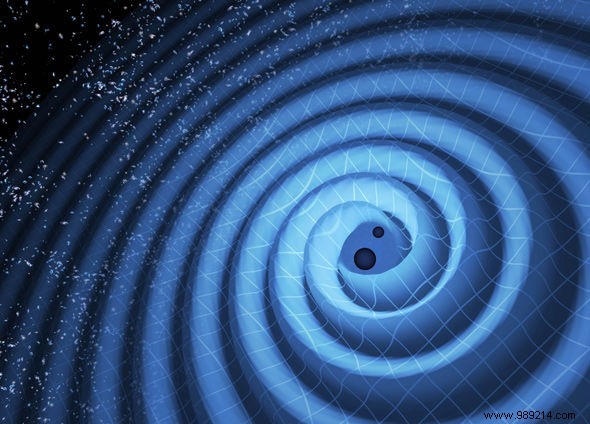Seven billion years ago, two massive black holes united as one. The latter would be of intermediate mass, an "elusive" object class.
LIGO (USA) and VIRGO (Italy) are the two largest gravitational wave detectors in the world. In September 2015, these two instruments detected their first ripples in the fabric of spacetime:signals generated by the merger of two black holes about 1.3 billion light-years away. Since then, other unions have been detected. Some have involved other black holes, while others have involved neutron stars.
A team of researchers today announced that they have recorded the most massive black hole collision ever detected using gravitational waves. The two objects, 66 and 85 solar masses , then formed a single black hole as massive as 142 suns (there was a loss of mass during the fusion).
Furthermore, these two black holes met about seven billion light-years away of the earth. In other words, the waves resulting from their forced union traveled for half the age of the universe, before finally reaching us.
Interestingly, this last black hole also falls into the class of intermediate-mass black holes .
There are indeed different types of black holes in the Universe. On the one hand we have stellar mass objects (less than 100 solar masses), formed by the collapse of a massive star. And on the other hand the "supermassives", with masses equivalent to millions or billions of suns. Between these extremes are more discrete members of the black hole family:those of intermediate mass.
These are particularly difficult to find. To do this, it is necessary to wait for a star to pass a little too close to be disturbed. The black hole, again active, can then emit X-rays indirectly betraying their presence. The Hubble Telescope recently had the opportunity to isolate one of these objects. This new detection made by LIGO and VIRGO therefore confirms their existence.

Finally, the heavier of the two original black holes contradicts what we know about stellar evolution. The latter indeed falls into the so-called "pair instability" gap.
“Based on our understanding of how stars age and evolve, we expect to find black holes with less than 65 solar masses, or more than 135 solar masses, but none in between” , explains Frank Ohme, from the Max Planck Institute for Gravitational Physics (AEI) in Hannover.
The 85-solar-mass black hole involved in this merger fits precisely into this gap . To justify its presence, the researchers suggest that it could be the product of previous mergers involving either two small black holes or two larger stars.
Details of this work have been published in Physical Review Letters and The Astrophysical Journal Letters . Note that the two observatories detected 56 possible gravitational wave events during their third cycle of operation, between April 1, 2019 and March 27, 2020. Of this sample, another 52 are still being analyzed.